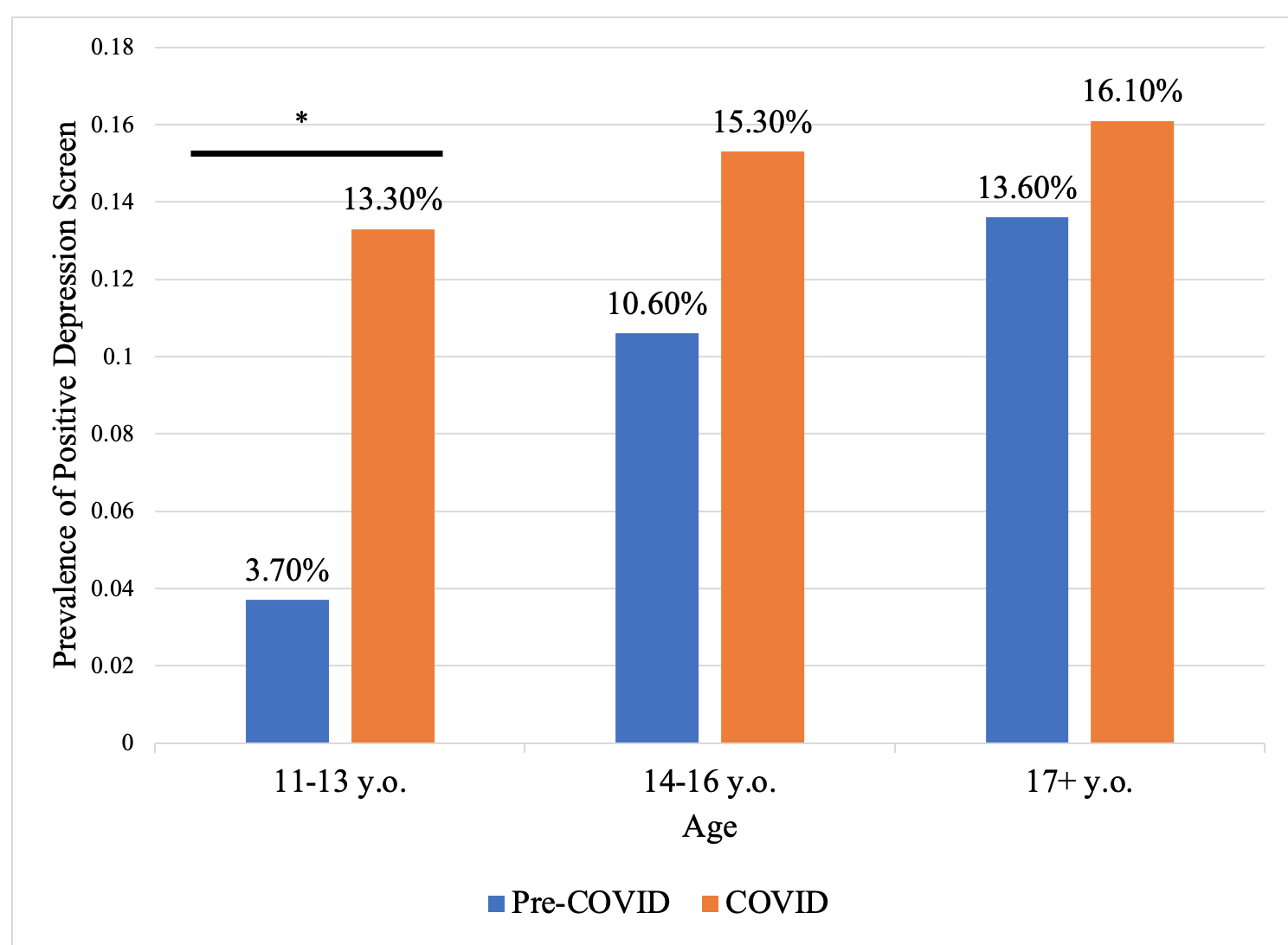Back
Mental Health
Category: Abstract Submission
Mental Health II
540 - Impact of the COVID-19 Pandemic on Mental Health of Black Adolescents in Underserved New York City Neighborhoods
Monday, April 25, 2022
3:30 PM – 6:00 PM US MT
Poster Number: 540
Publication Number: 540.423
Publication Number: 540.423
Athanasia Bouliari, SUNY DOWNSTATE MEDICAL CENTER, Brooklyn, NY, United States; Molly Schneider, State University of New York Downstate Medical Center College of Medicine, Brooklyn, NY, United States; Jatnna E. Soto, State University of New York Downstate Medical Center College of Medicine, Brooklyn, NY, United States; Anusha Bai Kalithkar, State University of New York Downstate Medical Center College of Medicine, Brooklyn, NY, United States; Meseret Tena, State University of New York Downstate Medical Center College of Medicine, Brooklyn, NY, United States; Jessie Cai, State University of New York Downstate Medical Center College of Medicine, Brooklyn, NY, United States; Perry Kerner, State University of New York Downstate Medical Center College of Medicine, Brooklyn, NY, United States; Lily Lee, SUNY Downstate College of Medicine/School of Public Health, Brooklyn, NY, United States; Isaac I. Effiong, University Hospital of BrooKlyn, Brooklyn, NY, United States; Eugene Dinkevich, SUNY Downstate Health Sciences University, Mount Vernon, NY, United States

Jatnna Soto, MD (she/her/hers)
Resident
SUNY Downstate - Brooklyn, NY
Brooklyn, New York, United States
Presenting Author(s)
Background: The COVID-19 pandemic has significantly impacted adolescent mental health around the globe. Black youth with fewer financial resources, in neighborhoods with higher infection rates and heavier disease burden, may be particularly susceptible to pandemic-related mental health complications. Understanding these dynamics is vital to the proper allocation of limited resources to high-need communities, particularly those facing preexisting disparities in mental health treatment.
Objective: To evaluate the prevalence of depressive symptoms in an urban pediatric clinic, serving primarily under-resourced Black adolescents in Central Brooklyn before and during the pandemic.
Design/Methods: The PHQ-9 was routinely administered to patients 11-21 years old at well-child visits. The cutoff for positive depression screen was ≥ 10. We compared positive scores pre-pandemic (June 2019–February 2020) to during the pandemic (April–December 2020). Demographics (age, gender, race, ethnicity and insurance) were obtained from EMR. For bivariate analyses, chi-squares were used for categorical and t-tests for continuous variables. Multivariate logistic regression was used to test for relationships between demographic variables and positive depression screens.
Results: The sample included 554 adolescents (50.9% Male, 98.4% Black, and 65.5% Medicaid), 312 before and 242 during the pandemic. The prevalence of positive screens increased across the sample from before (9.0%) to during (14.9%) the pandemic (p=.031). Furthermore, prevalence increased among girls (p=.05) (Figure 1) and 11-13 year-olds (p=.022) (Figure 2). Prior to the pandemic, multivariate logistic regression showed that the odds of positive screen was higher for females compared to males (OR=2.88; 95% CI 1.19, 6.98) and for 17+ year olds compared to 11-13 year olds (OR=4.08; 95% CI 1.25,13.35). No association with demographic variables was found. During the pandemic, these demographic relationships lost their significance. In a separate regression, including all samples across time periods, when adjusting for gender, race, ethnicity, age, and insurance status, only intra-pandemic time period increased the odds of positive depression screen (OR=1.79, 95% CI 1.05, 3.06).Conclusion(s): Our study shows that the COVID-19 pandemic increased the odds of positive depression screen by 80%, in our predominantly low-income, Black population in New York City. The change was particularly noteworthy in girls and younger adolescents. As the pandemic continues, our findings highlight the importance of allocating resources to improve mental health outcomes in these groups.
Figure 1..png) Prevalence of positive PHQ9 by gender and time period. *p ≤ 0.05
Prevalence of positive PHQ9 by gender and time period. *p ≤ 0.05
Figure 2. Prevalence of positive PHQ9 by age and time period. *p ≤ 0.05
Prevalence of positive PHQ9 by age and time period. *p ≤ 0.05
Objective: To evaluate the prevalence of depressive symptoms in an urban pediatric clinic, serving primarily under-resourced Black adolescents in Central Brooklyn before and during the pandemic.
Design/Methods: The PHQ-9 was routinely administered to patients 11-21 years old at well-child visits. The cutoff for positive depression screen was ≥ 10. We compared positive scores pre-pandemic (June 2019–February 2020) to during the pandemic (April–December 2020). Demographics (age, gender, race, ethnicity and insurance) were obtained from EMR. For bivariate analyses, chi-squares were used for categorical and t-tests for continuous variables. Multivariate logistic regression was used to test for relationships between demographic variables and positive depression screens.
Results: The sample included 554 adolescents (50.9% Male, 98.4% Black, and 65.5% Medicaid), 312 before and 242 during the pandemic. The prevalence of positive screens increased across the sample from before (9.0%) to during (14.9%) the pandemic (p=.031). Furthermore, prevalence increased among girls (p=.05) (Figure 1) and 11-13 year-olds (p=.022) (Figure 2). Prior to the pandemic, multivariate logistic regression showed that the odds of positive screen was higher for females compared to males (OR=2.88; 95% CI 1.19, 6.98) and for 17+ year olds compared to 11-13 year olds (OR=4.08; 95% CI 1.25,13.35). No association with demographic variables was found. During the pandemic, these demographic relationships lost their significance. In a separate regression, including all samples across time periods, when adjusting for gender, race, ethnicity, age, and insurance status, only intra-pandemic time period increased the odds of positive depression screen (OR=1.79, 95% CI 1.05, 3.06).Conclusion(s): Our study shows that the COVID-19 pandemic increased the odds of positive depression screen by 80%, in our predominantly low-income, Black population in New York City. The change was particularly noteworthy in girls and younger adolescents. As the pandemic continues, our findings highlight the importance of allocating resources to improve mental health outcomes in these groups.
Figure 1.
.png) Prevalence of positive PHQ9 by gender and time period. *p ≤ 0.05
Prevalence of positive PHQ9 by gender and time period. *p ≤ 0.05Figure 2.
 Prevalence of positive PHQ9 by age and time period. *p ≤ 0.05
Prevalence of positive PHQ9 by age and time period. *p ≤ 0.05